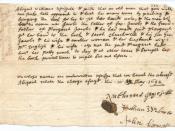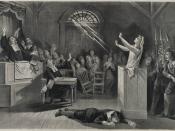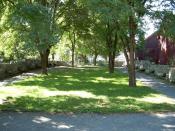If someone saw girls dancing naked in the woods today, they probably wouldn't put them on trial. In early colonial times, it would have been considered a sign of witchcraft and a sin! In Arthur Miller's "The Crucible", a story of that kind of odd behavior is told about the now infamous Salem witch trials. In 1692, a group of young women were caught dancing in the woods and witchcraft hysteria went rampant through Salem, Massachusetts. The political, social, and environmental settings in the late seventeenth century Salem were instrumental in heightening the probability of the witch trials in this Puritan village.
The government of seventeenth century Salem, Massachusetts is very different from today. When the Puritans arrived, they established a strict theocracy in their colony. Their government was completely entwined with their church. Religious moral codes became the laws. Anything immoral could get them arrested. Reverend Parris preaches compliance with the church rules and the local laws when he says, "there is either obedience or the church will burn like Hell is burning!" (28).
People were punished for breaking simple laws. Abigail says, "Uncle, we did dance; let you tell them I confessed it- and I'll be whipped if I must be," (9).
Just as church and state are intertwined, the characters' social lives are also tied together in The Crucible. The small community forms a tight knit group and privacy is
very hard to maintain. Everyone knows everyone else's business and it's easy to see how rumors spread easily. In Act I, Abigail speaks to her uncle about what she suggests he do, "Uncle, the rumor of witchcraft is all about; I think you'd best go down and deny it yourself. The parlor's packed with people, sir," (9). The people are all congregating to discuss what they've...


